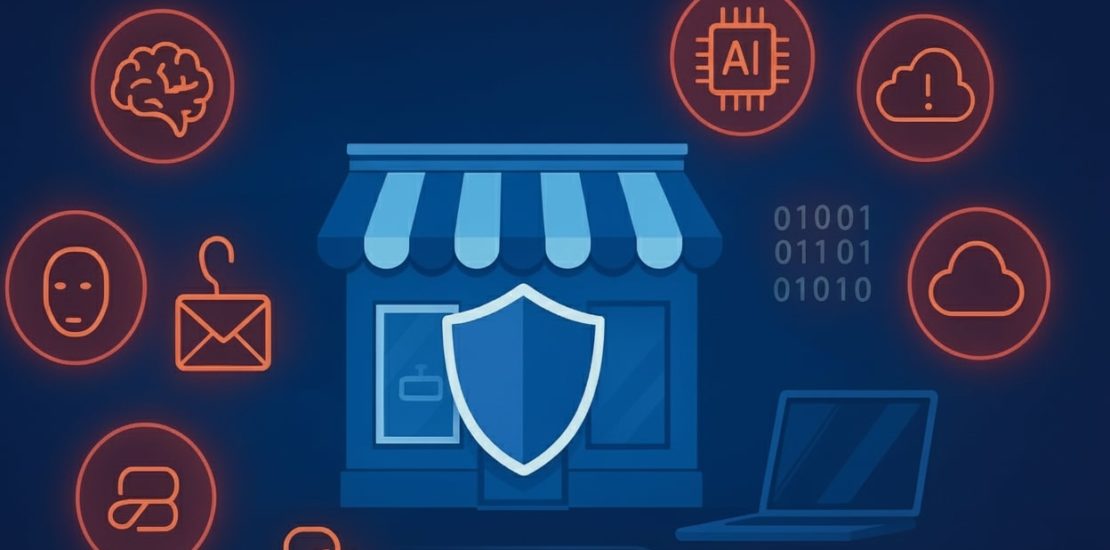Top 5 AI-Driven Threats Facing UK SMEs & How to Protect Against Them
- October 13, 2025
- Posted by: Gradeon
- Category: Cyber Security

In 2025, AI is transforming business, but it’s also empowering adversaries. UK small and medium enterprises (SMEs) must now contend with AI-driven threats that are faster, smarter, and more deceptive than ever. Below, we explore the five most urgent threats and practical strategies SMEs can adopt to defend themselves.
1. Hyper-Personalised AI Phishing & Spear-Phishing
What it is:
Attackers now use generative AI to automatically craft deeply personalised phishing emails—mirroring brand tone, referencing public data about your company, even mimicking writing style.
These phishing campaigns are harder to detect and can reach multiple employees simultaneously.
Why SMEs are vulnerable:
SMEs often lack advanced email monitoring or dedicated security teams. A single compromised account or well-crafted email can be enough to seed a breach.
How to defend:
- Deploy advanced email filtering systems with AI/ML detection capabilities.
- Enable multi-factor authentication (MFA) for all email and critical accounts.
- Conduct regular phishing simulation training to help staff spot subtle cues.
- Establish protocols for verifying unusual requests (e.g. via alternate channels).
2. Deepfake & Voice Cloning Impersonation
What it is:
Cybercriminals now deploy AI tools to clone voices or generate deepfake video calls impersonating executives, suppliers, or partners. For example, a convincing video or audio message could demand urgent payment.
In one documented case, UK firm Arup lost £20 million after a deepfake video call impersonated senior staff.
Why SMEs are vulnerable:
Smaller firms may rely on trust and informal processes, making them easier to trick into making large transfers or disclosing sensitive data.
How to defend:
- Institute dual-approval or escalation protocols for large transfers.
- Train staff to verify unusual voice/video requests via separate channels.
- Use secure, authenticated video conferencing platforms with identity checks.
- Maintain logs of requests and require confirmation before acting.
3. Shadow AI Usage & Data Leakage
What it is:
“Shadow AI” refers to employees using unauthorized consumer AI tools (e.g. ChatGPT, Bard, etc.) for work tasks—uploading proprietary or customer data into models not sanctioned by the company. In the UK, 71% of employees have used unapproved AI tools at work.
This opens paths for inadvertent data leakage, model poisoning, or exposure to malicious prompt injection.
Why SMEs are vulnerable:
SMEs often adopt AI tools to boost productivity, but without governance or controls. The absence of oversight increases risks.
How to defend:
- Create and enforce an AI usage policy: only approved, vetted tools allowed for business use.
- Monitor AI interactions and audit logs for suspicious data uploads.
- Use enterprise-grade AI platforms with built-in security, data isolation, and governance.
- Educate staff on the risks of copying sensitive data into AI models.
4. Automated Vulnerability Discovery & Weaponised AI Scanning
What it is:
Attackers now use AI to rapidly scan for vulnerabilities in network systems, APIs, web portals, or software infrastructure. Once a weakness is located, exploit code and attack strategies can be generated automatically.
These tools scale what used to be manual reconnaissance into mass scanning across many targets simultaneously.
Why SMEs are vulnerable:
SMEs often run standard software, use third-party plugins, and may lag behind in patching. This makes them ripe targets for automated exploitation.
How to defend:
- Conduct regular vulnerability scanning and penetration testing (internally or via trusted third parties).
- Maintain a robust patch management program—apply updates promptly.
- Use web application firewalls (WAFs) and intrusion detection/prevention systems (IDS/IPS).
- Segment networks so that a breach in one area doesn’t automatically cascade.
5. AI-Driven Supply Chain Attacks & Dependency Risks
What it is:
Attackers target weaker links, vendors, software suppliers, third-party services—and insert malicious code, credentials, or AI-powered trojans into those dependencies. When SMEs integrate those components, the compromise spreads.
Because AI allows attackers to more efficiently map dependencies and craft customized payloads, supply chain attacks are rising.
Why SMEs are vulnerable:
Many SMEs rely heavily on third-party software, modules, or cloud services. They may not vet every dependency rigorously.
How to defend:
- Maintain an inventory of all software dependencies, plugins, and third-party services.
- Require vendors to comply with security standards (e.g. ISO 27001, Cyber Essentials).
- Use integrity checks, code signing, and software bill of materials (SBOM) approaches.
- Monitor for unexpected changes or anomalies in vendor components.
Summary Table & Priority Actions
| Threat | Key Risk | Priority Defense |
| AI-powered phishing | Credential theft, data breach | MFA + advanced email filters + phishing training |
| Deepfake impersonation | Fraudulent transfers, social engineering | Escalation protocols, verification processes |
| Shadow AI/data leakage | Exposed proprietary or customer data | Governance, approved AI tools, audit logging |
| Automated vulnerability scanning | Rapid exploitation of software flaws | Patching, scanning, segmentation |
| Supply chain injections | Hidden backdoors in dependencies | Vendor security audits, SBOM, integrity checks |
Final Thoughts & Next Steps
- Risk Assessment First
Conduct an internal review to identify your most critical assets, high-risk processes, and exposure to AI threats. - Layered Defence Strategy
Use defense-in-depth: technical controls and human awareness. No single tool is enough. - Ongoing Training & Testing
Periodically test staff resilience via phishing simulations and voice-simulation drills. - Adopt Standards & Certifications
Consider frameworks like Cyber Essentials or IASME Governance to formalize baseline security. - Stay Informed & Collaborate
Join UK SME cybersecurity forums or regional clusters (e.g. UK Cyber Security Forum) to share threat intelligence and best practices.
By proactively addressing these five AI-driven threats, UK SMEs can move from reactive to defensive posture, reducing business risk, protecting customer trust, and staying competitive in an increasingly AI-attacked world.
